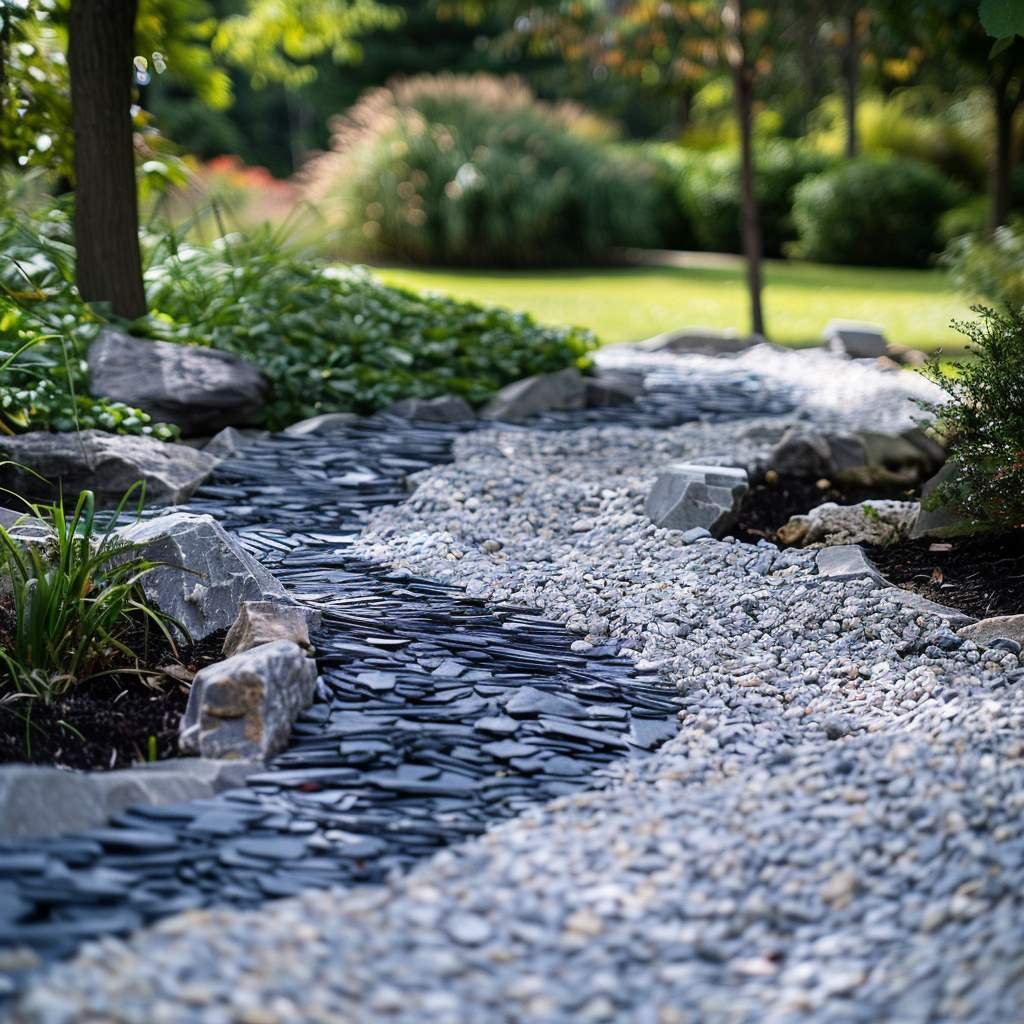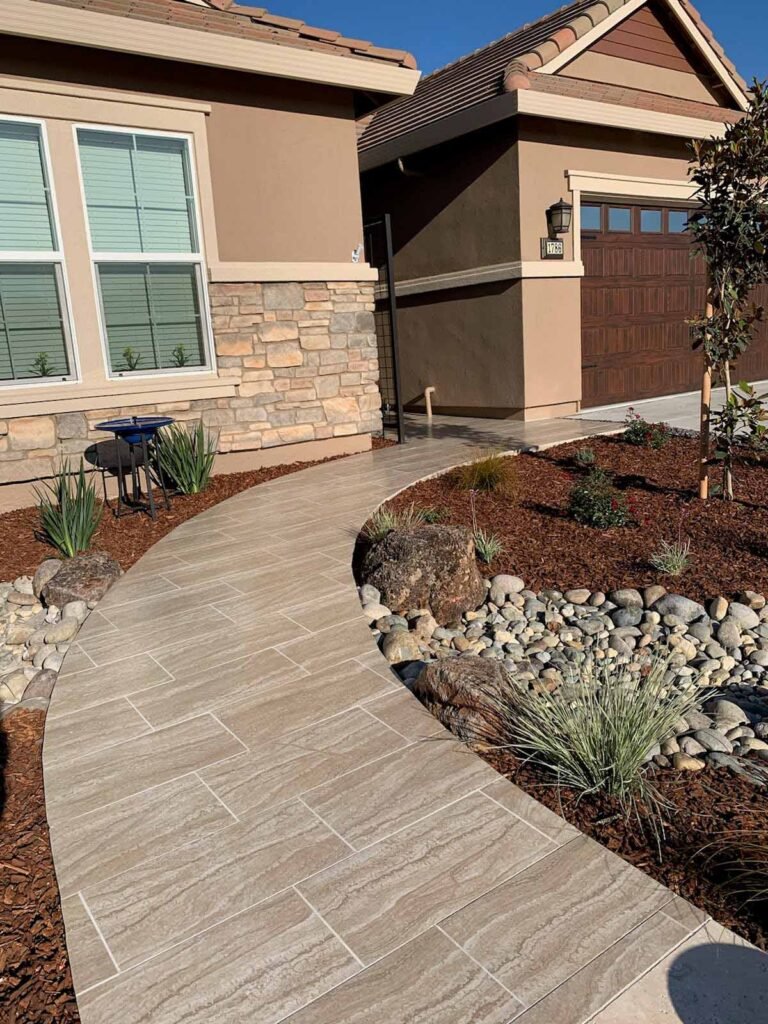Creating the perfect outdoor walkway is perfect for enhancing the look and functionality of your garden. There are several types of pathways you can choose from, including cobblestone, brick, pavers, and gravel.
Thoughtful planning and selecting natural stones can help you create an impressive entrance to your home that lasts throughout the seasons.
Key Takeaways
- Stone walkways offer unmatched durability and beauty.
- Different types of stone can fit various garden designs.
- Proper installation ensures a lasting, safe, and attractive path.
Exploring Types of Outdoor Walkways
Outdoor walkways come in various materials, each providing benefits to your landscaping. The choice of walkway influences the durability, look, and feel of your yard.
Gravel Walkways

Gravel walkways are easy to install and affordable. They offer excellent drainage, which helps prevent water buildup. These paths can be laid out quickly, making them perfect for DIY projects.
A major advantage of gravel is its versatility. It comes in many colors and sizes, allowing you to match it with your garden’s theme.
Considerations:
- May scatter with frequent use.
- Requires edging to keep gravel in place.
- Weeds may grow through the gravel if not properly treated.
Concrete Pathways

Concrete pathways are known for their durability and low maintenance. They are perfect for high-traffic areas and can withstand various weather conditions without much damage.
Customizable textures and patterns are available, allowing you to create a design that complements your outdoor space.
Considerations:
- Can be expensive to install.
- Might crack over time due to ground movement.
- Requires professional installation for best results.
Brick Pavements

Brick pavements bring a classic look to your outdoor area. These paths are durable and can be arranged in various patterns, adding visual interest to your landscape.
Bricks are relatively easy to replace if damaged, ensuring your pathway stays looking good for years. Colors range from reds and browns to more neutral tones, fitting different styles of gardens.
Considerations:
- Installation can be time-consuming.
- Higher initial cost compared to some materials.
- May need regular maintenance to prevent moss and weed growth.
Wooden Boardwalks

Wooden boardwalks offer a natural, rustic charm that blends beautifully with gardens and natural settings. They are ideal for areas where you want a soft, more organic feel.
Wood types like cedar, redwood, and pressure-treated pine are commonly used. These materials are chosen for their resistance to rot and insects.
Considerations:
- Regular maintenance to prevent rot and warping.
- May become slippery when wet.
- Initial installation can be costly.
Each type of walkway offers distinct benefits and can enhance the functionality and aesthetic of your outdoor space. Choose the one that best fits your needs and complements your garden.
Advantages of Stone Walkways
Stone walkways offer numerous benefits, making them an excellent choice for any outdoor space. They showcase unmatched durability and provide a beautiful look that enhances any garden or yard.
Durability and Longevity
Stone walkways are extremely durable. Materials like limestone, granite, and slate withstand heavy foot traffic and harsh weather conditions.
Natural stone can last for decades with minimal maintenance. Stones are easy to clean, usually requiring only occasional sweeping or rinsing with water. Properly installed stone walkways stay level and safe over time.
Aesthetics and Design
Stone walkways bring a timeless beauty to any landscape. Stones come in various colors, shapes, and sizes, allowing you to create unique patterns and designs.
Choosing the Right Stone for Your Walkway

Selecting the right stone for your walkway is important for both functionality and aesthetics. You’ll want to consider factors like durability, appearance, and maintenance requirements.
Granite Slabs
Granite slabs are an excellent choice for walkways due to their extreme durability and resistance to weathering. Granite is a very hard stone that can withstand heavy foot traffic and harsh weather conditions without showing significant signs of wear.
They are also easy to clean, needing only occasional washing with water to maintain their appearance. While granite can be more expensive than other options, its longevity and minimal maintenance can effectively offset the higher initial cost.
Slate Tiles
Slate tiles offer a unique, rustic look that can make your walkway stand out. This metamorphic rock features natural clefts and grooves, adding texture and character to your path.
Slate is fairly durable and can withstand seasonal changes, making it a good fit for most climates. It requires sealing every couple of years to keep it in top condition.
Flagstone Pavers
Flagstone pavers are widely popular for their versatility and natural appearance. They can be laid out in various patterns, such as irregular, random, or traditional designs, allowing you to create a custom look.
This stone is durable, able to handle heavy foot traffic and extreme weather conditions. Flagstone requires minimal maintenance, mostly limited to occasional sweeping and washing.
Installation Insights for Stone Walkways
Preparing the Area
Start by marking where you want your stone walkway. Use stakes and string to outline your path.
Dig out the area to a depth of about 6–8 inches. This way, you can add layers for stability.
Creating a Strong Base
Add a layer of compactible gravel or coarse sand. This will be your base.
Use a rake to spread the material evenly. Aim for a base depth that supports the stones without shifting.
Tip: Compact the gravel or sand to make sure the base is solid and level.
Setting the Stones
Lay down a layer of sand or stone dust. This helps to create a smooth surface for placing the stones.
Arrange your stones according to your design. Maintain consistent spacing to ensure an even look.
Once the stones are in place, tap them gently with a rubber mallet to ensure they are secure.
Filling the Gaps
Fill the gaps between the stones with sand or polymeric sand. This helps to lock the stones in place.
Sweep the sand into the gaps and use a hose to lightly wet the area. This will help the sand settle.
Repeat this process until the gaps are fully filled.
Final Touches
Check the walkway for any uneven stones. Add or remove sand underneath to guarantee they are level.
Clean up any excess material around the walkway. Make sure the edges are tidy and free from loose gravel or sand.
